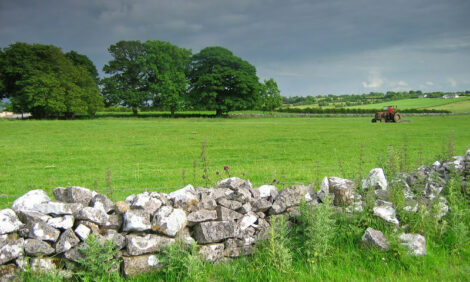



Virtual Fences For Real Livestock?
BRISBANE - A virtual fence for livestock that allows better use of pasture, protects the environment and reduces labour, is being developed by the CSIRO Food Futures Flagship using satellite technology.| Dr Caroline Lee and Dr Andrew Fisher with a electronic collar containing advanced software to warn cattle that they are approaching a virtual fence line. Photo supplied by: The Land |
The project is focussed on developing an animal-friendly virtual fencing system for cattle that enables the animals to be confined without using fixed fences. At this stage in the development of what is designed to be a commercial product, the research team has developed a prototype system and successfully demonstrated its use on a herd of cattle.
CSIRO’s Dr Andrew Fisher said the system works in a similar way to a conventional electric fence for livestock, except that the fence is invisible. It is a major improvement on existing virtual fencing approaches.
“The boundaries are drawn entirely by GPS and exist only as a line on a computer,” Dr Fisher said “There are no wires or fixed transmitters used at all. Importantly, what we’re developing, achieves the same result as a conventional fence but without the need for posts and wire.”
The system employs electronic collars which emit a sound to warn the cattle when they are approaching a virtual boundary line.
Conducted strictly in line with animal welfare requirements, the virtual fencing project involves collaboration – under the umbrella of the Food Futures Flagship – between CSIRO Livestock Industries in Armidale and the CSIRO ICT Centre in Brisbane.
"Importantly, what we’re developing, achieves the same result as a conventional fence but without the need for posts and wire."
Dr Fisher .
”Research team member, CSIRO Livestock Industries’ Dr Caroline Lee, said the collars contain advanced software to identify when a cow is near a fence line and which signal should be emitted.
“Signal timing and duration are based on the behaviour of the cow, and the animals can learn about a virtual fence for the first time in less than an hour and avoid the fence boundary,” Dr Lee said. “The cattle learn, by associating the sound signal with their behaviour of approaching the virtual fence boundary which is programmed into the collars.”
The scientists conducted measurements, overseen by an independent animal welfare expert, which show the animals are not unduly stressed by the virtual fence.
According to CSIRO ICT Centre researcher, Dr Tim Wark, once the boundary is set, the sensor-based system is fully automated and self-sufficient. It also enables farmers to continuously monitor where their cattle are located.
“Although there is still some work to be done in areas such as smart-power management before the system is commercially viable, we can envisage a farm of the future where farmers can fence their property from the comfort of their homesteads,” Dr Wark said.
© Copyright CSIRO Australia


